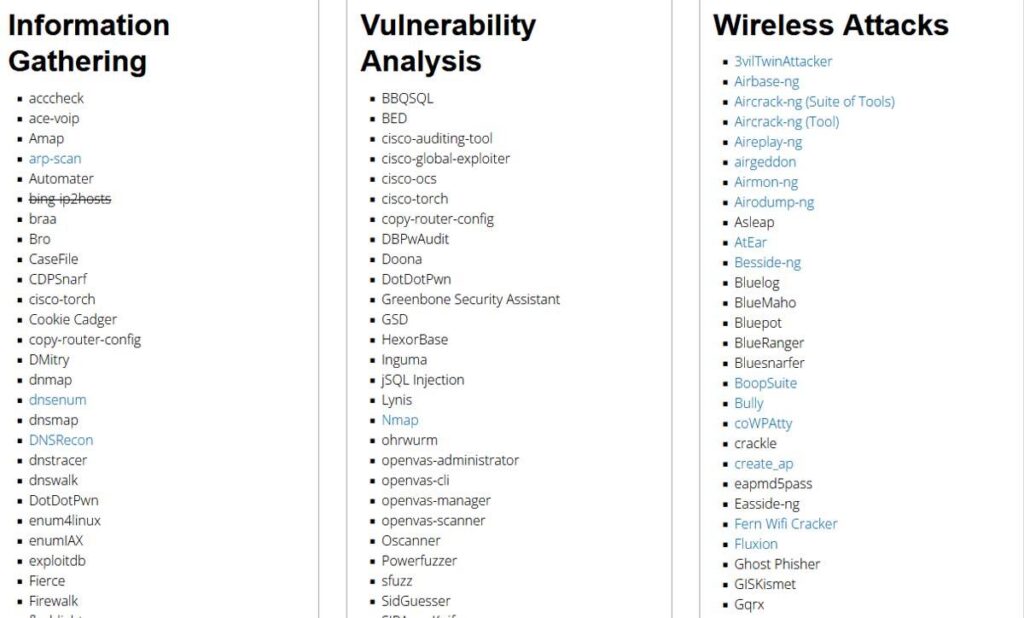Kali Linux and Parrot OS are two popular Linux distributions widely used in the field of penetration testing. Both platforms offer a range of powerful tools and capabilities that allow security professionals to assess the vulnerabilities of computer systems and networks.
In this article, we will compare Kali Linux and Parrot OS in-depth, comparing their capabilities, usability, tool sets, community support, and other factors.
We want to assist you in selecting the Linux distribution that is most appropriate for your penetration testing needs by examining the advantages and disadvantages of each.
- 1. Introduction to Kali Linux and Parrot: An Overview
- 2. Comparison of Kali Linux and Parrot OS: Features and Capabilities
- 3. Performance and Stability: Kali Linux vs Parrot OS
- 4. Tools and Applications for Penetration Testing: Kali Linux vs Parrot OS
- 5. User-Friendliness and Interface: Kali Linux vs Parrot OS
- 6. Community Support and Updates: Kali Linux vs Parrot OS
- 7. Choosing the Right Operating System for Your Penetration Testing Needs
- 8. Conclusion: Which is the Best Operating System for Pentesting – Kali Linux or Parrot OS?
- 8. Conclusion: Which is the Best Operating System for Pentesting – Kali Linux or Parrot OS?
1. Introduction to Kali Linux and Parrot: An Overview
1.1 What is Kali Linux?
Kali Linux exudes immense power, as it stands as a prominent and favored Linux distribution laser-focused on the art of penetration testing and ethical hacking. Its foundation is
Kali Linux provides a comprehensive toolkit for professionals and enthusiasts in the field of cybersecurity.
1.2 What is Parrot OS?
Parrot OS, on the other hand, is another Linux distribution focused on security and privacy.
It offers a similar set of tools for penetration testing and digital forensics but with its own unique features and a user-friendly interface.
Parrot OS aims to provide a secure and reliable platform for ethical hacking and protects users’ privacy.
2. Comparison of Kali Linux and Parrot OS: Features and Capabilities

2.1 Core Features of Kali Linux
Kali Linux boasts an extensive collection of over 600 pre-installed tools, covering a wide range of cybersecurity and penetration testing functionalities.
It supports various wireless devices and provides advanced exploitation capabilities.
Kali Linux also offers excellent compatibility with hardware and provides regular updates to ensure the latest security patches and tool updates.
2.2 Core Features of Parrot OS
Similarly, Parrot OS provides a rich set of tools for penetration testing and digital forensics.
It focuses on privacy and includes features like sandboxing applications, anonymous web browsing, and built-in cryptographic tools.
Parrot OS also offers a customizable and user-friendly interface, making it accessible for both beginners and experienced users.
2.3 Similarities and Differences in Features
Both Kali Linux and Parrot OS offer comprehensive toolsets for cybersecurity professionals.
They share many common tools and functionalities, such as network analysis, vulnerability assessment, and password cracking.
However, the key difference lies in their additional features and interface design.
Kali Linux leans towards a more hardcore and specialized approach, while Parrot OS emphasizes accessibility and privacy.
3. Performance and Stability: Kali Linux vs Parrot OS
3.1 Performance Evaluation of Kali Linux
Kali Linux excels in terms of performance, especially when running on powerful hardware.
Its lightweight nature allows it to utilize system resources efficiently, resulting in a smooth and responsive experience.
However, users with older or less capable hardware may experience slower performance, particularly when running resource-intensive tools.
3.2 Performance Evaluation of Parrot OS
Parrot OS offers comparable performance to Kali Linux, providing a stable and responsive environment for penetration testing.
Its optimized package management system ensures efficient resource utilization, even on less powerful hardware.
Parrot OS is generally well-suited for various hardware configurations, making it a reliable choice for users with diverse setups.
3.3 Stability Comparison between Kali Linux and Parrot OS
Both Kali Linux and Parrot OS strive for stability, but occasional bugs or issues may arise due to the constant development and updates of their respective toolsets.
However, as they are community-driven distributions, updates, and bug fixes are regularly released to maintain stability and address any reported problems.
Users can rely on the strong communities behind both distributions for support and updates.
4. Tools and Applications for Penetration Testing: Kali Linux vs Parrot OS
4.1 Penetration Testing Tools in Kali Linux

Kali Linux offers an extensive range of tools for various aspects of penetration testing, such as network scanning, vulnerability assessment, wireless testing, and exploitation.
It includes popular tools like Nmap, Wireshark, Metasploit, and Burp Suite. These tools are continuously updated and well-maintained by the Kali Linux community, ensuring their effectiveness and reliability.
4.2 Penetration Testing Tools in Parrot OS
Parrot OS provides a similar set of tools to Kali Linux for penetration testing. It includes widely used tools like Aircrack-ng, John the Ripper, Nikto, and Hashcat.
Identical to Kali Linux, Parrot OS ensures that these tools are up-to-date and compatible with the latest vulnerability discoveries and security standards.
4.3 Comparison of Toolsets
Although there may be some overlap, each distribution offers its own selection of specialized tools and utilities.
The choice between Kali Linux and Parrot OS ultimately depends on the user’s specific needs and preferences.
Kali Linux’s vast collection of tools makes it suitable for professionals seeking a comprehensive penetration testing environment.
Parrot OS, with its user-friendly interface and focus on privacy, is a great option for beginners or those concerned about data security.
Overall, both Kali Linux and Parrot OS provide robust toolsets and reliable platforms for ethical hacking and penetration testing.
Choosing between them boils down to personal preference, level of expertise, and specific requirements. So, pick the one that best suits you, because, in the end, it’s all about hacking with style!
5. User-Friendliness and Interface: Kali Linux vs Parrot OS
5.1 User-Friendly Features of Kali Linux
When it comes to user-friendliness, Kali Linux might not win any awards. It’s a powerful operating system designed specifically for penetration testing and cybersecurity professionals, so it’s not tailored for beginners.
However, if you’re willing to put in the time to learn its intricacies, it can be a valuable tool in your arsenal.
Kali Linux provides a vast range of pre-installed tools and utilities for testing and auditing networks, which is a big advantage.
It also has extensive documentation and an active community that can help you navigate through any hurdles you might encounter.
5.2 User-Friendly Features of Parrot OS
Parrot OS, on the other hand, takes a more user-friendly approach.
It aims to provide a secure and easy-to-use operating system for everyone, including beginners who are just starting their journey into the world of penetration testing.
Parrot OS offers a sleek and modern interface that is visually appealing and intuitive.
It comes with a user-friendly setup wizard and a wide range of tools suitable for both professionals and newcomers.
It also has built-in tools for privacy protection and anonymization, making it a versatile choice for those concerned about their online security.
5.3 Interface Comparison
In terms of interface, Parrot OS takes the lead with its user-friendly design and modern aesthetics.
Its visually pleasing interface makes it easier for beginners to navigate and find the tools they need.
Kali Linux, on the other hand, has a more utilitarian design that focuses on functionality rather than aesthetics.
While it may not be as visually appealing, it offers a more comprehensive suite of tools for advanced penetration testing.
6. Community Support and Updates: Kali Linux vs Parrot OS
6.1 Community Support for Kali Linux
Kali Linux has a massive and dedicated user community that provides excellent support to its users.
With forums, mailing lists, and various online resources, you can find answers to almost any question or issue you might encounter during your pentesting journey.
Additionally, Kali Linux has regular updates and security patches, ensuring that you have access to the latest tools and the most up-to-date security features.
6.2 Community Support for Parrot OS
Parrot OS also benefits from a strong and helpful community. Although not as large as Kali Linux’s community, it still offers a good support network through forums and online communities.
Parrot OS also has a dedicated bug tracker, allowing users to report issues and contribute to the improvement of the operating system.
6.3 Update Frequency and Reliability
Both Kali Linux and Parrot OS are actively maintained and receive regular updates.
Kali Linux follows a rolling release model, which means you’ll have access to the latest tools and updates without the need for frequent reinstallation.
Parrot OS also provides regular updates and security patches to ensure stability and reliability.
7. Choosing the Right Operating System for Your Penetration Testing Needs
When it comes to choosing between Kali Linux and Parrot OS, it ultimately depends on your experience level and specific needs.
If you’re a seasoned cybersecurity professional or have experience with Linux, Kali Linux offers a vast array of tools and customization options for advanced penetration testing.
On the other hand, if you’re a beginner or prefer a more user-friendly and visually appealing interface, Parrot OS might be a better fit.
It provides a streamlined experience without compromising on the key features required for effective penetration testing.
Consider your level of expertise, the specific tools you require, and the overall user experience when making your decision.
8. Conclusion: Which is the Best Operating System for Pentesting – Kali Linux or Parrot OS?
In the end, there is no definitive answer to which operating system is the best for pentesting.
Both Kali Linux and Parrot OS have their strengths and weaknesses.
Kali Linux offers a more extensive range of tools and customization options, making it a go-to choice for professionals.
Parrot OS, on the other hand, provides a more user-friendly experience without compromising on essential features.
It’s important to evaluate your own needs, skills, and preferences before making a decision.
Whichever operating system you choose, remember that it’s the skill and expertise of the user that truly matters in the realm of penetration testing.
So, grab your favorite OS and start exploring the exciting world of ethical hacking!
8. Conclusion: Which is the Best Operating System for Pentesting – Kali Linux or Parrot OS?
After a thorough comparison of Kali Linux and Parrot OS, it becomes apparent that both operating systems offer impressive features and capabilities for penetration testing.
Kali Linux is renowned for its extensive toolset and long-standing reputation in the field, while Parrot OS brings a user-friendly interface and strong community support.
Ultimately, the choice between the two comes down to personal preference and specific requirements.
It is recommended to experiment with both systems and assess their suitability based on your unique needs and preferences.
Regardless of the choice, both Kali Linux and Parrot OS serve as reliable and robust options for conducting effective pentesting operations.

